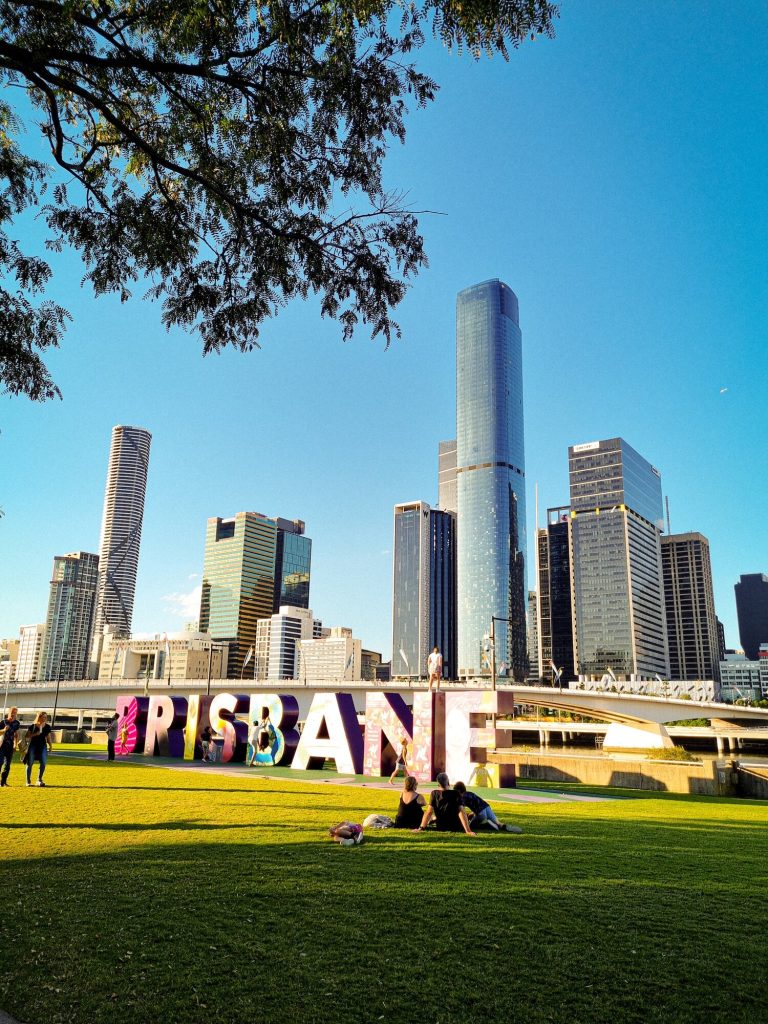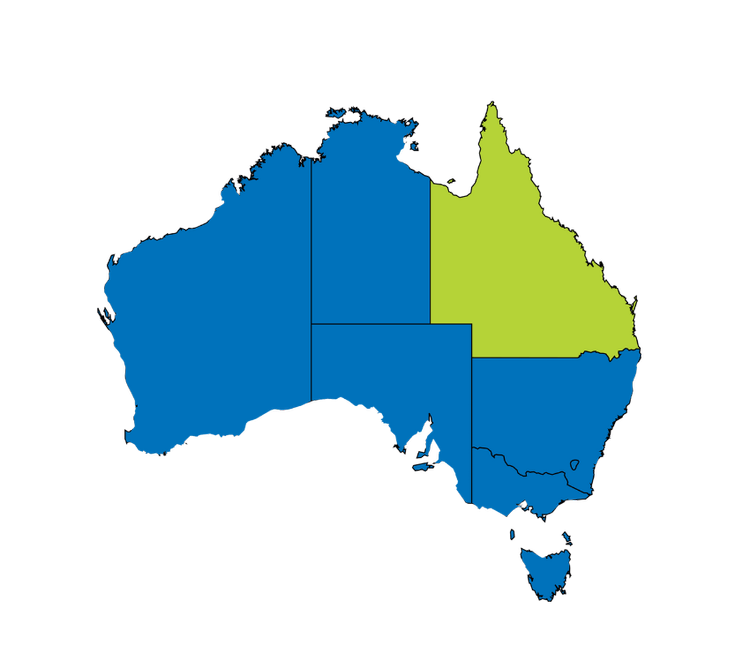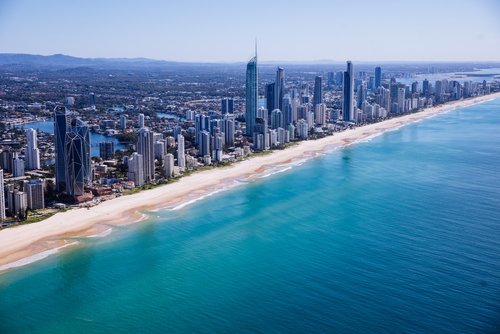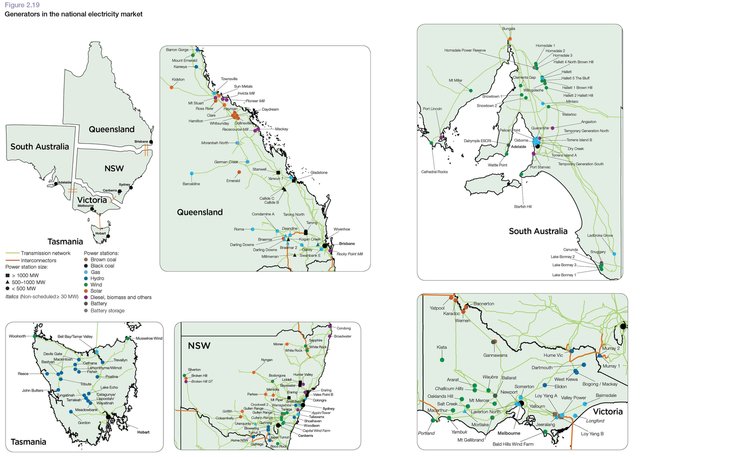



Queensland has a population of over 5.3 million, the majority of whom live along the eastern coast. The capital city is Brisbane, with other large cities of Gold Coast, Sunshine Coast, Townsville, Cairns, Ipswich and Toowoomba.
Queensland has more than 943,601 homes and businesses that have installed a solar system, and 11,549 have a solar battery too. To harness the sun’s power to heat their homes, 337,056 have installed a solar water heater or air source heat pump.
Queensland has also installed 49 wind turbines. (source – Clean Energy Regulator).
The Australian PV Institute estimates the percentage of dwellings with a PV system to be 43.9%. This is the highest state for the percentage of dwellings with renewable energy. what an outstanding achievement.
Queensland has committed to 70% renewable energy by 2032, and 80% by 2035, and has a clear plan to drive investment to deliver clean, reliable and affordable energy. Currently, 24.9% of electricity used in Queensland is produced from renewable energy sources.
But with a $10.8 Billion investment, and 52 large-scale projects either operational, under construction or financially committed, Queensland is well on its way to becoming the powerhouse state of renewable energy. (source – Queensland Government – department of energy and public works )
The number of solar systems installed grows each day, as more households realise the benefits that such a system has on their power bills and the environment. Don’t let renewable energy savings pass you by any longer, take action today to see what benefits a renewable energy system could have on your bills and the positive impact on the environment.
Queensland’s Electricity Grid

Queensland is part of the National Electricity Market (NEM) and Powerlink Queensland as the high voltage transmission network service provider, which is owned by the Queensland Government. You sign up with a choice of retailers, either on a standard or market retail contract.
To find an energy plan that meets your needs, Energy Made Easy is a great site by the Australian Government and can be accessed here. Please ensure you shop around to get the best deal, and make sure you consider the Feed-in Tariff (FITS) when looking at your energy provider, as when you choose a renewable energy system, you want to get paid for the excess power your system produces.
Rebates and Incentives
Government Incentive – Small-scale Technology Certificates (STC)
When you install a renewable energy solution, you are entitled to claim Small-scale Technology Certificates (STCs) against the cost of the system. An STC is equal to 1 megawatt-hour of renewable electricity, either generated or displaced by eligible small-scale renewable energy systems such as solar PV, wind, hydro, solar water heaters and air source heat pumps.
The STCs are part of the Australian government’s Renewable Energy Target. STCs fluctuate a little in the marketplace and are generally always claimed on the customer’s behalf by the retailer installing your system.
You can claim them yourself via the REC Registry, however, it is much easier to allow your trusted and endorsed installer to claim them on your behalf. At the time of writing this, STCs are trading at $40 each, however, they have been as low as $16 per STC.
To see an up-to-date price please click here. At $40 per STC, this means for a 5kw inverter with 6.6kw of panels one can expect a reduction of $ 3,000.
The Clean Energy Regulator provides a free STC Calculator for you to establish how many STCs your renewable energy solution will generate. If you would like to see what your STC rebate would be with a ‘live’ price right now!
Greenbank Environmental can provide this here.
Feed-in tariffs (FITS)
Within Queensland you could potentially be eligible for a payment for any electricity you produce, do not self-consume and export back to the grid. This is known as a Feed-in Tariff. In Queensland, you have a multitude of retailers to choose from for your electricity.
Please pay attention when choosing your electricity retailer, as just because they have a higher FIT, this may not result in lower bills as they may have a higher supply charge or unit rate. In May 2023, you could get 5-15c FIT from AGL, 0-14c OVO Energy, 2-12c Origin Energy, 6.6-10c Energy Australia, 6-9c Simply Energy, 6-12c Sumo,……the list is endless, in Queensland you have a massive array to choose from.
If you would like to compare the best solar feed-in tariffs and electricity plans, then check out WATTever here.
Electric Vehicles (EVs)
The Queensland Government is currently offering a $3,000 rebate, for buyers of new eligible zero-emission vehicles with a purchase price of up to $58,000. More information from the Queensland Government shifting to zero-emission vehicles can be found here.
| Retailer | Min Solar FIT | Max Solar FIT | Conditions |
|---|---|---|---|
| OVO Energy | 0.0 c | 14.0 c | |
| Sumo | 6.0 c | 12.0 c | |
| Origin Energy | 2.0 c | 12.0 c | Only if buy solar through Origin – 10kW max |
| AGL | 5.0 c | 12.0 c | System size 10kW max |
| GloBird Energy | 1.0 c | 11.0 c | |
| Energy Locals | 10.2 c | 10.2 c | |
| EnergyAustralia | 6.6 c | 10.0 c | System size 30kW max |
| Ergon Energy | 9.3 c | 9.3 c | |
| Alinta Energy | 8.0 c | 8.0 c | System size 5kW max |
| Simply Energy | 7.0 c | 7.0 c | |
| Radian Energy | 7.0 c | 7.0 c | |
| Momentum Energy | 0.0 c | 7.0 c | |
| 1st Energy | 6.0 c | 6.0 c | |
| CovaU | 5.5 c | 5.5 c | |
| Diamond Energy | 0.0 c | 5.2 c | |
| Dodo | 5.0 c | 5.0 c | |
| Tango Energy | 5.0 c | 5.0 c | Capped at 3.5kWh per day |
| Red Energy | 5.0 c | 5.0 c | Capped at 5kWh per day |
| Ampol Energy | 5.0 c | 5.0 c | |
| Nectr | 0.0 c | 3.8 c | |
| Powershop | 0.0 c | 3.5 c | Feed-in tariff is only for systems up to 10kW in NSW QLD and SA. |
| Kogan Energy | 0.0 c | 2.9 c | |
| Amber Electric | 0.0 c | 0.0 c | |
| ReAmped Energy | 0.0 c | 0.0 c |
